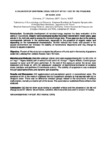Use este identificador para citar ou linkar para este item:
http://www.alice.cnptia.embrapa.br/alice/handle/doc/1038471Registro completo de metadados
| Campo DC | Valor | Idioma |
|---|---|---|
| dc.contributor.author | CLEMENTE, Z. | pt_BR |
| dc.contributor.author | MARTINEZ, D. S. T. | pt_BR |
| dc.contributor.author | CASTRO, V. L. S. S. de | pt_BR |
| dc.date.accessioned | 2016-02-24T11:11:11Z | pt_BR |
| dc.date.available | 2016-02-24T11:11:11Z | pt_BR |
| dc.date.created | 2016-02-24 | pt_BR |
| dc.date.issued | 2015 | pt_BR |
| dc.identifier.citation | In: CONGRESS OF TOXICOLOGY IN DEVELOPING COUNTRIES, 9.; CONGRESSO BRASILEIRO DE TOXICOLOGIA, 19., 2015, Natal. Anais... Sociedade Brasileira de Toxicologia; International Union of Toxicology, 2015. | pt_BR |
| dc.identifier.uri | http://www.alice.cnptia.embrapa.br/alice/handle/doc/1038471 | pt_BR |
| dc.description | Sustainable development of nanotechnology requires the deep evaluation of the safety of its products. Despite nanotoxicological studies have been intensified in recent years, gaps remain in the methods used to assess the nanotechnology risks. These gaps are due to the complex nanomaterials behavior in the environment, especially in the presence of organic matter and depending on the nanomaterial characteristics. Studies indicate that humic acid present in the aquatic environment can increase the stability of nanomaterial dispersions and may change its toxicity to aquatic organisms. | pt_BR |
| dc.language.iso | eng | eng |
| dc.rights | openAccess | eng |
| dc.title | Evaluation of graphene oxide toxicity by fet test in the presence of humic acid. | pt_BR |
| dc.type | Resumo em anais e proceedings | pt_BR |
| dc.date.updated | 2016-02-24T11:11:11Z | pt_BR |
| dc.subject.nalthesaurus | Graphene oxide | pt_BR |
| riaa.ainfo.id | 1038471 | pt_BR |
| riaa.ainfo.lastupdate | 2016-02-24 | pt_BR |
| dc.contributor.institution | Z. CLEMENTE; D. S. T. MARTINEZ, CNPEM; VERA LUCIA SCHERHOLZ S DE CASTRO, CNPMA. | pt_BR |
| Aparece nas coleções: | Resumo em anais de congresso (CNPMA)  | |
Arquivos associados a este item:
| Arquivo | Descrição | Tamanho | Formato | |
|---|---|---|---|---|
| 2015RA090.pdf | 14.14 kB | Adobe PDF |  Visualizar/Abrir |









